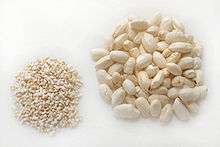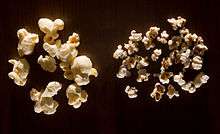Puffed grain

Puffed grains have been made for centuries with the simplest methods like popping popcorn. Modern puffed grains are often created using high temperature, pressure, or extrusion.
People eat puffed grains in many ways, but it can be as simple as puffed grain alone and with salt for taste. Commercial products such as Corn Flakes and Corn Pops mix many ingredients into a homogeneous batter. The batter is then formed into shapes then toasted and/or extruded. This causes them to rise, but not puff or pop. Puffed grains are very healthy if plain, but when other ingredients are mixed with them they lose some of their previous health benefits.[1]
Puffed grains are popular as breakfast cereals and in the form of rice cakes. While it is easy to recognize that cereals came from whole grains, the expansion factor for rice cakes is even greater, and the final product is somewhat more homogeneous.
History
The oldest puffed grain was found in west central New Mexico in 1948 and 1950. Ears of popcorn were found that were up to 4,000 years old. These pieces of puffed grain were smaller than a penny to two inches in size and can be made in a similar way to popping popcorn.[2] The modern process of making puffed grains was invented by Dr. Alexander P. Anderson in 1901. He was doing an experiment dealing with the effect of heat and pressure on corn starch granules where he put them in six glass tubes, sealed them, and put them in an oven until they changed color. When Dr. Anderson took them out and cracked them open an explosion happened, he had made the corn starch turn into a puffed, white mass.[3] Dr. Alexander’s invention of puffed grain was first introduced at the World’s Fair in St. Louis in 1904. The puffed grain was shot from a battery of eight guns and on a poster it was called “The Eighth Wonder of the World.”
Manufacture

High pressure puffed grain is created by placing whole grains under high pressure with steam in a containment vessel. When the vessel's seal is suddenly broken, the entrained steam then flashes and bloats the endosperm of the kernel, increasing its volume to many times its original size.

Puffed rice or other grains are occasionally found as street food in China, Korea (called "ppeong twigi" 뻥튀기), and Japan (called "pon gashi" ポン菓子), where hawkers implement the puffing process using an integrated pushcart/puffer featuring a rotating steel pressure chamber heated over an open flame. The great booming sound produced by the release of pressure serves as advertising.
Manufacturing puffed grain by venting a pressure chamber is essentially a batch process. To achieve large-scale efficiencies, continuous-process equipment has been developed whereby the pre-cooked cereal is injected into a high pressure steam chamber. It then exits the steam chamber via a Venturi tube to an expansion chamber, where the puffed cereal is collected and conveyed to the next process step. These devices, generally called stream puffing machines, were perfected in the latter half of the 20th century in Switzerland and Italy, but are now available from manufacturers in China as well.
Puffable foods


Grains
- Amaranth – Has been grown in Mexico, Central America, India, Nepal, China, East Africa, and the U.S. for the past two centuries.[4]
- Barley – Is grown in North and South Dakota, Utah, Oregon, Idaho, Canada, and parts of the Sahara Desert.[5]
- Kamut – This is a brand name for an ancient heritage grain called khorasan wheat.
- Maize/corn (as popcorn) – Starchy grain native to the Americas [6]
- Millet – This name refers to several different annual summer grasses used for hay, pasture, silage, and grain. Millet is most commonly grown in Kentucky in the U.S.[7]
- Oat – Can and are grown in every continental state of the U.S. Overwintering kinds of oats are grown in the Cotton Belt and in western parts of the U.S.[8]
- Rice – Grown in more than 100 countries, but about 90% is grown in Asia. Other major producers are Sub-Saharan Africa and Latin America. Puffed rice is an ingredient of bhel puri, a popular Indian chaat (snack). It is offered to Hindu gods and goddesses in all poojas in the South Indian states of Kerala and Tamil Nadu. Puffed rice has been made in India for few centuries. [9]
- Sorghum – In the U.S., most commonly grown in the dry plains of Texas and South Dakota. Also grown in parts of Africa and Asia where it is too hot for corn.[10]
- Spelt – Has been grown in Europe for about 300 years and was introduced to the U.S. in the late 1800s. Most of the spelt grown in the U.S. comes from Ohio.[11]
- Wheat – Biggest producing countries are China, Russia, U.S., India, and Canada.[12]
Non-grains
- Buckwheat – Russia has the largest amount being grown because that is where it is native to, but it can also be planted in the northern plains of the U.S.[13]
- Makhana – Grown in Korea, Japan, and China. 63% comes from the Bihar wetlands.
- Quinoa – Currently being grown mainly in the U.S., Canada, and South America but can be almost anywhere.[14]
- Soybeans – For the U.S. it is mainly grown in the Midwest and the main producing countries are Brazil, Argentina, China, India, Paraguay, Canada, and Italy.[15]
Examples
Puffed grain foods
Snacks and food products made from puffed grain include:
- Alegría (amaranth) – Mexico
- Bhelpuri (rice)
- Bamba (corn)
- Golden Crisp (wheat)
- Puffed rice
- Honey Smacks (wheat)
- Toffee Crisp (rice)
- Pufarine (wheat) – Romania
Puffed dough foods
References
- ↑ "Puffed Rice Nutrition." LIVESTRONG.COM. N.p., n.d. Web. 08 Apr. 2013.
- ↑ "History of Popcorn." History of Popcorn. N.p., n.d. Web. 08 Apr. 2013.
- ↑ "Dr. Alexander P. Anderson - 1982 Inductee." Minnesota Inventors Hall of Fame -. N.p., n.d. Web. 08 Apr. 2013.
- ↑ "Amaranth." Amaranth. N.p., n.d. Web. 08 Apr. 2013.
- ↑ "Barley (x Elyhordeum Mansf. Ex Zizin & Petrowa)." Forage Fact Sheet: Barley. N.p., n.d. Web. 08 Apr. 2013.
- ↑ "Popcorn." Popcorn. N.p., n.d. Web. 08 Apr. 2013.
- ↑ "How to Grow Millet | Guide to Growing Millet." How to Grow Millet | Guide to Growing Millet. N.p., n.d. Web. 08 Apr. 2013.
- ↑ "Oats." Oats. N.p., n.d. Web. 08 Apr. 2013.
- ↑ "Rice Production and Processing." irri.org. N.p., n.d. Web. 8 Apr. 2013.
- ↑ "Grain Sorghum (Milo)." Grain Sorghum (Milo). N.p., n.d. Web. 08 Apr. 2013.
- ↑ "Spelt." Spelt. N.p., n.d. Web. 08 Apr. 2013
- ↑ "Where Wheat Grown." ThinkQuest. Oracle Foundation, n.d. Web. 08 Apr. 2013.
- ↑ "Growing Buckwheat: Production Tips, Economics, and More." Growing Buckwheat: Production Tips, Economics, and More. N.p., n.d. Web. 08 Apr. 2013.
- ↑ "Quinoa - All About Grains." Quinoa - All About Grains. N.p., n.d. Web. 08 Apr. 2013.
- ↑ "Related Links." Soybeans. N.p., n.d. Web. 08 Apr. 2013.
Further reading
| Wikimedia Commons has media related to Puffed grains. |
- Research notebooks and papers of the inventor of the process of puffing rice and starches, Alexander P. Anderson, are available for research at the Minnesota Historical Society
- Making muri (traditional puffed rice)
- Puffed rice